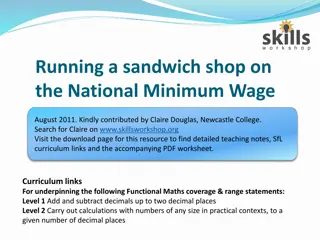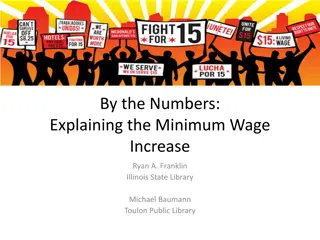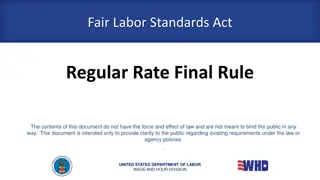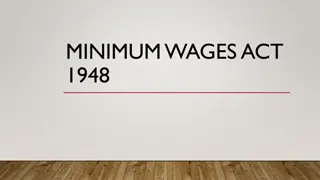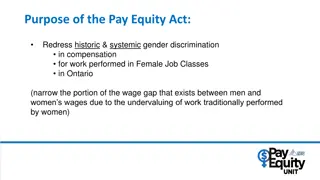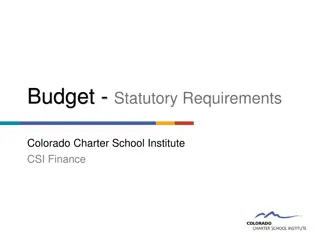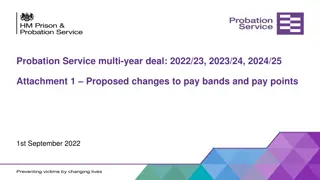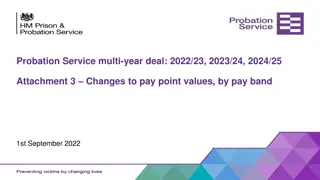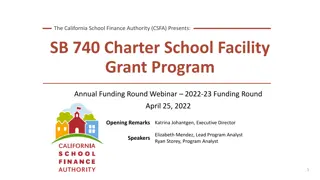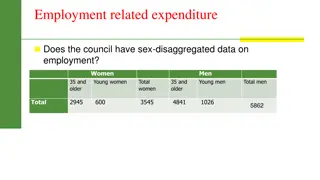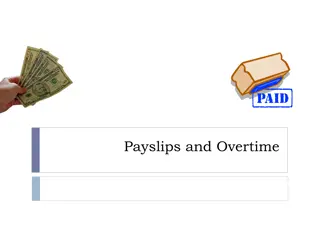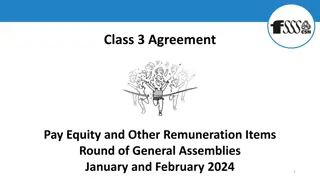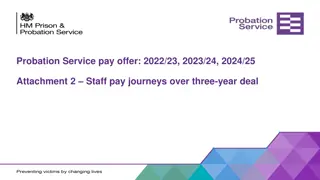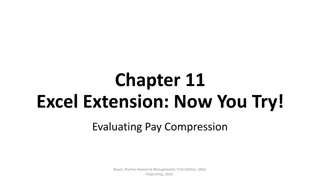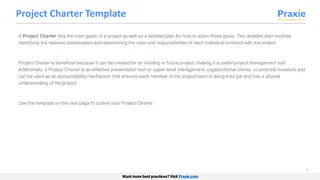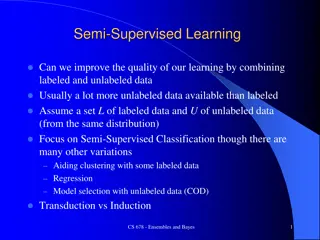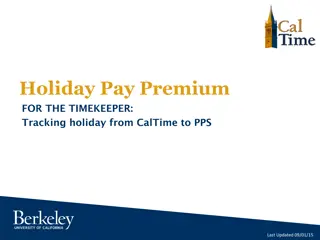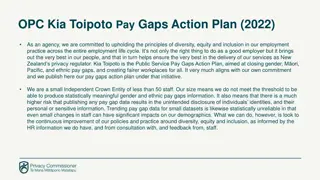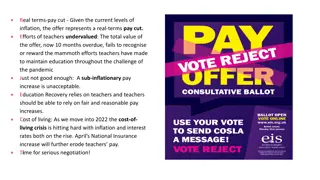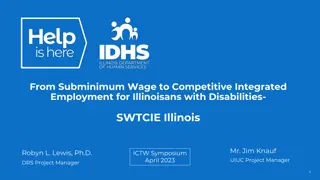Impact of New Minimum Wage and Semi-Monthly Pay on Charter Schools
Presentation by Kari Wallace at the CCSA Conference on how the progressive increase in California's minimum wage affects exempt/non-exempt classifications and the introduction of semi-monthly payrolls. The presentation discusses key details, including Delta Managed Solutions' experience, labor code projections, Federal and local minimum wage comparisons, and implications for exempt/non-exempt classifications.
Download Presentation

Please find below an Image/Link to download the presentation.
The content on the website is provided AS IS for your information and personal use only. It may not be sold, licensed, or shared on other websites without obtaining consent from the author. Download presentation by click this link. If you encounter any issues during the download, it is possible that the publisher has removed the file from their server.
E N D
Presentation Transcript
How the New Minimum Wage and Semi-Monthly Pay will Impact Charter Schools CCSA Conference March 13, 2019 Presented by: Kari Wallace, HR/Payroll Supervisor DMS
Purpose of Presentation Present the progressive increase to California Minimum Wage Explain how the increase impacts exempt/non-exempt classifications Outline the need for semi-monthly payrolls Discuss some best practices to alleviate the California Legislation decision 2
Delta Managed Solutions (DMS) 15 Years of Consistent & Stable Growth California-Only, Charter-Only Focus 27 Clients serving 53 Charter Schools 43 Dedicated & Experienced Staff Members All Payroll Run In-House including STRS/PERS retirement reporting 100 % Employee Owned Company 3
1. Progressive Minimum Wage: Senate Bill No. 3 amending Labor Code Section 1182.12 Two sets of criteria Employers with more than 25 employees Employers with less than 25 employees Federal Minimum Wage Local Ordinances 4
1. Progressive Minimum Wage: Labor Code Projections Minimum Wage for Employers with 25 Employees or Less Minimum Wage for Employers with 26 Employees or More Date January 1, 2017 January 1, 2018 January 1, 2019 January 1, 2020 January 1, 2021 January 1, 2022 January 1, 2023 $10.00/hour $10.50/hour $11.00/hour $12.00/hour $13.00/hour $14.00/hour $15.00/hour $10.50/hour $11.00/hour $12.00/hour $13.00/hour $14.00/hour $15.00/hour 5
1. Progressive Minimum Wage: Federal Minimum Wage $7.25 hr. 6
1. Progressive Minimum Wage: Local Ordinances override state wage El Cerrito Emeryville Los Angeles (city) Los Angeles County Pasadena San Diego San Francisco Santa Monica Sunnyvale 7
2. Exempt / Non-Exempt Classifications 8
2. Exempt / Non-Exempt Classifications Exempt Criteria: Not entitled to overtime pay Must be paid a salary Must earn a minimum annual, monthly or weekly salary that is double that of the state minimum wage (Salary Test) Must fit into specific job category performing exempt job duties (Duties Test) 9
2. Exempt / Non-Exempt Classifications Exempt Requirements: Administrative, Executive, Professional, and Computer Professional duties Employer bears Burden of Proof to show exemption Salary can t change, same each pay period Salary Test - Can use Annual, Monthly or Weekly salary minimum salary Required salary cannot be prorated for work less than full-time Salary test is based on State of California minimum wage, not local ordinances Can be paid on a 10, 11 or 12 month basis Federal Exempt qualifications do not apply to teachers 10
2. Exempt / Non-Exempt Classifications Duties Test: Administrative Performance of work directly related to management policies or general business operations Performance of functions in the administration of a school system or educational institution and work directly related to academic instruction or training Discretion and independent judgment Executes under only general supervision Executive Management of the enterprise or department or subdivision Customarily and regularly directs the work of two or more employees Has the authority to hire/fire or change of status of employees Discretion and independent judgment Professional Licenses or Certified by State of California Learned or Artistic Profession Discretion and independent judgment 11
2. Exempt / Non-Exempt Classifications Salary Test: Annual Exempt Limit Date Rate Monthly Amt. $ 45,760.00 $ 3,813.33 1/1/2018 $11/hour $ 49,920.00 $ 4,160.00 1/1/2019 $12/hour $ 54,080.00 $ 4,506.67 1/1/2020 $13/hour $ 58,240.00 $ 4,853.33 1/1/2021 $14/hour $ 62,400.00 $ 5,200.00 1/1/2022 $15/hour $ 62,400.00 $ 5,200.00 1/1/2023 $15/hour 12
2. Exempt / Non-Exempt Classifications Non-Exempt Criteria: Entitled to overtime based on the California Industrial Wage order Can be paid a salary or an hourly wage Subject to Minimum Wage Can work in any field or in the case of education can be Classified, Certificated, or Administrative 13
2. Exempt / Non-Exempt Classifications Non-Exempt Requirements: Must fill out a timesheet and document meal and rest breaks Meal Break 30 minute meal break if working 5 hours or more Must start by the end of the 5thhour Must be paid for Overtime for Over 8 hours in a day Over 40 hours in a week First 8 hours on the 7thconsecutive day of a workweek Must be paid at least twice per month 14
Topics For This Section Why Semi-Monthly Payrolls are Good Practice Considerations for making a Change 16
3. Semi-Monthly Payrolls Why Make the Change? Labor Code 204 (a) All wages, other than those mentioned in Section 201, 201.3, 202, 204.1, or 204.2, earned by any person in any employment are due and payable twice during each calendar month, on days designated in advance by the employer as the regular paydays. Labor performed between the 1st and 15th days, inclusive, of any calendar month shall be paid for between the 16th and the 26th day of the month during which the labor was performed, and labor performed between the 16th and the last day, inclusive, of any calendar month, shall be paid for between the 1st and 10th day of the following month. 17
3. Semi-Monthly Payrolls Labor Code 204 However, salaries of executive, administrative, and professional employees of employers covered by the Fair Labor Standards Act, as set forth pursuant to Section 13(a)(1) of the Fair Labor Standards Act, as amended through March 1, 1969, in Part 541 of Title 29 of the Code of Federal Regulations, as that part now reads or may be amended to read at any time hereafter, may be paid once a month on or before the 26th day of the month during which the labor was performed if the entire month s salaries, including the unearned portion between the date of payment and the last day of the month, are paid at that time. 18
3. Semi-Monthly Payrolls Considerations: Culture of your staff Retirement reporting what are your county s expectations Other payroll Liabilities, i.e.; 403b, 401a, FSA Timekeeping systems Pay Dates 19
4. Best Practices How does this impact your budget? Salaries - Single largest expense in the budget Therefore, plan carefully to ensure all staff are correctly budgeted 21
4. Options for Best Practices Audit Classified and Certificated salary schedules Ensure they are meeting minimum wage requirements Update each fiscal year Update each calendar year Consider your budget at both 1stInterim and 2nd interim 22
4. Best Practices Classified Salary Schedule 23
4. Best Practices Certificated Salary Schedule Range A Range B Range C Range D Range E Range F Step 1 $ 45,760.00 $ 46,260.00 $ 46,760.00 $ 47,260.00 $ 47,760.00 $ 48,260.00 Step 2 $ 46,260.00 $ 46,760.00 $ 47,260.00 $ 47,760.00 $ 48,260.00 $ 48,760.00 Step 3 $ 46,760.00 $ 47,260.00 $ 47,760.00 $ 48,260.00 $ 48,760.00 $ 49,260.00 Step 4 $ 47,260.00 $ 47,760.00 $ 48,260.00 $ 48,760.00 $ 49,260.00 Step 5 $ 47,760.00 $ 48,260.00 $ 48,760.00 $ 49,260.00 Step 6 $ 48,260.00 $ 48,760.00 $ 49,260.00 Step 7 $ 48,760.00 $ 49,260.00 Step 8 $ 49,260.00 24
4. Best Practices Certificated Salary Schedule Range A Range B Range C Range D Range E Range F Step 1 $ 49,920.00 $ 50,420.00 $ 50,920.00 $ 51,420.00 $ 51,920.00 $ 52,420.00 Step 2 $ 50,420.00 $ 50,920.00 $ 51,420.00 $ 51,920.00 $ 52,420.00 $ 52,920.00 Step 3 $ 50,920.00 $ 51,420.00 $ 51,920.00 $ 52,420.00 $ 52,920.00 $ 53,420.00 Step 4 $ 51,420.00 $ 51,920.00 $ 52,420.00 $ 52,920.00 $ 53,420.00 Step 5 $ 51,920.00 $ 52,420.00 $ 52,920.00 $ 53,420.00 Step 6 $ 52,420.00 $ 52,920.00 $ 53,420.00 Step 7 $ 52,920.00 $ 53,420.00 Step 8 $ 53,420.00 25
4. Options for Best Practices Minimum Wage OT Rate # Average Hrs. OT per pay period Per Pay Period Cost Per Year 11 month employee (22 periods) $7,920.00 Monitor Overtime of Non-Exempt Staff Employees $12.00 $18.00 10 20 $360.00 26
4. Options for Best Practices Consider Calendars and Exempt staff pay dates o 10 pay or 11 pay with Deferred Pay Monthly Exempt = Annual Minimum / 12 months $49,920.00 / $4,160.00 Pay 10 Months = Multiply by 10 = $41,600.00 Pay 11 Months = Multiply by 11 = $45,760.00 Deferred Pay = an additional deduction withheld on the employee s net wages so that all taxes and benefits are collected as earned. The Deferred Pay is then paid back in June/July and does not include any additional deductions. 27
4. Options for Best Practices 10 Pay $41,600 = $4,160 / mo. Hold 2/10thof Net = $832 $832 x 10 mo = $8,320 June $4,160 July $4,160 11 Pay $45,760 = $4,160 / mo. Hold 1/11thof Net = $378.18 $378.18 * 11 = $4160
4. Options for Best Practices Analyze FTE s Certificated Exempt Staff vs. Classified Non- Exempt staff reallocate by removing Classified FTE and adding to Certificated FTE or add to Certificated Salary Schedule 1 FTE Classified Employee 8 hr. day 185 days - $12.00 hr. $17,760.00 29
4. Options for Best Practices Use part-time staff for lower-level positions where possible and reasonable OR shared contracts Teacher Daily Rate = $49,920.00 / 185=$269.84 Classified Employee at $12 / hr. 8 hrs. day = $96 (keep in mind the part-time staff must be paid on a semi-monthly cycle and complete a timesheet) 30
4. Options for Best Practices Be Pro-Active to initiate Legislation: Lobby Groups Local Legislature California State Education Committee https://aedn.assembly.ca.gov/ 31
Questions? Resources: www.ca.gov www.dol.gov www.FLSA.us.gov www.edd.ca.gov www.calchamber.com 32



